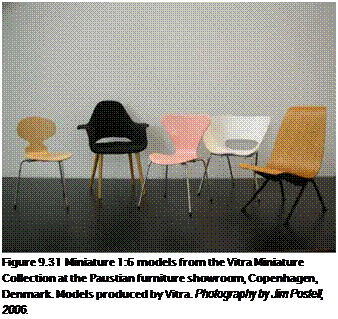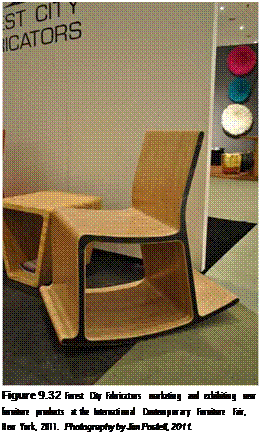Design at Herman Miller is a way of looking at the world and how it works—or doesn’t. It is a method for getting something done, for solving a problem. . .
—From Herman Miller’s corporate values statement, "Things that Matter"
Industry giants such as Bernhardt Company, Baker Furniture, the Bittner’s Group, Thom Moser, Verbargs, and Arhaus (Cleveland, Ohio) are examples of traditional and contemporary production companies that attempt to extend their market share by competing directly in the retail market and the public domain. They work to brand their merchandise, reaching customers directly through journals and magazine advertising and investing in retail-based showrooms. More often than not, they reach out to consumers interested in both current trends and traditional home furnishings. Their appeal is based on the quality of workmanship, value, availability, and branded line of products.
Williams-Sonoma Home, Crate and Barrel, Armani, Casa, Pottery Barn, Target, West Elm, and many other retailers are joining the recent efforts of department stores such as Macy’s,

 |
 |
Kohl’s, and JCPenney to redefine domestic trend furniture. Home goods is a huge area and provides a great opportunity for furniture designers.
Artek, B & B Italia, Cassina, Fritz Hansen, Haworth,
IKEA, Kartell, Knoll, Vitra, and Zanotta are furniture design and production companies. They have strong relationships within the culture of contemporary architecture and design in general. These companies market and advertise through a number of venues, including journals and magazines, art venues, furniture exhibitions, miniatures, and an extensive network of showrooms and retail stores (Figures 9.29, 9.30, and 9.31). They maintain links with popular culture and the offices of leading architects and designers through marketing, aggressive pricing, production, and distribution strategies. Industrial production, economies of production, limits of distribution, and links with popular culture are extremely important in the conception and fabrication of contemporary works by these and many other companies.
Online and Web-based companies such as the California-based Design Within Reach (www. dwr. com); England’s Web-based outlet for contemporary works, Habitat (www. habi- tat. co. uk); West Elm; Conrad’s; Hold Everything; Frontgate; Sharper Image; and Europe’s
 TopdeQ (www. topdeq. com) have established a new and convenient way for people to search for and purchase furniture from their home and office using catalogs and the Internet.
TopdeQ (www. topdeq. com) have established a new and convenient way for people to search for and purchase furniture from their home and office using catalogs and the Internet.
Many furniture designs never reach the marketplace. Putting a design idea into production requires investment, and investment requires economic viability. But equally important are the nature of the market at which the product is aimed and the degree to which furniture design can be protected from competition (Figure 9.32). The market value of the product must be greater than its cost to produce, market, and distribute in order to justify the investment required. The net profit should augment an acceptable return on the investment in plant and working capital.
Assessing the value and marketability of furniture design is difficult. The value of a design often depends on the market niche at which the product is aimed: monogrammed beanbag chairs for children, vibrating massage loungers for the stressed, and lift chairs or wheelchairs for those with limited mobility. Furniture attracts niche market clientele and, more often than not, is marketed in such a manner.
Some market niches in the furniture industry are slow to adopt new technologies, whether or not these technologies enable a more durable, safer, or less expensive product. Those who desire traditional stained and finished wood furniture that is handmade most likely will continue to do so. These individuals will likely not seek out the latest polymer or recycled material incorporated in design. Likewise, those accustomed to sitting upright at the dining table will probably not adopt the Asian or Turkish model of sitting closer to the floor when sharing a meal. Markets are focused realities. This is as true today as it was centuries ago when Chippendale, Hepplewhite, and Sheraton worked to market their products.
What works well in one culture may not work in another. The cultural lifestyles and social norms of people need to be understood in conjunction with the furniture that is sought, desired, and needed by people finishing their home, office, or place of business in order to market effectively and attract consumers.
ENDNOTES
1. www. brainyquote. com/quotes/authors/j/james_randolph_adams. htm.
2. Interview with Boris Berlin of Komplot Design, June 2006.
3. Nigel Collett, "The New Look in Retail Design—Popping Up in a Street Near You," Brand Republic, June 14, 2005, p. 132.
4. Data gathered on Italian furniture production in 1989 during a three-month study in Milan.
![]()


